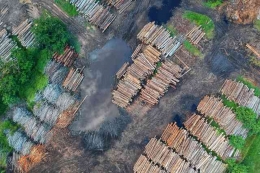What we initially perceive as right and the best way forward might, in fact, be wrong due to limited considerations and knowledge. With the increasing awareness of the environmental impact of single-use plastic, many have shifted to paper bags and alternative packaging. However, this awareness often lacks depth in understanding how paper bags and alternative packaging also pose serious threats to climate change and overall environmental sustainability.
The transition from single-use plastic bags to paper bags and other alternative materials was initially seen as a positive step towards sustainability. However, a comprehensive examination reveals that while these alternatives offer some benefits, they also present significant threats to climate change and overall environmental sustainability.
At first glance, paper bags seem like a more environmentally friendly choice due to their biodegradability and potential for recycling. However, their production exacts a toll on the environment. The manufacturing process for paper bags demands significant resources, primarily wood pulp obtained from trees. This reliance contributes directly to deforestation, a major cause of climate change.
Observing the trend of transitioning from plastic to paper bags and other alternative packaging materials brings about adaptations in the practices of the paper and cardboard industry. The popularity of paper packaging surged in the twentieth century and is now utilized across various applications such as food packaging, consumer electronics packaging, and protective packaging. In 2019, paper and cardboard accounted for over 33 percent of the global demand for packaging materials (Statista Research Department, 2023).
The rising demand for paper packaging
Post-digitization, many believed that the paper industry would fade away, yet the paper packaging sector has weathered the storm. Despite the surge in digital media usage leading to a global decline of over 30 percent in graphic paper production since 2010, the production of packaging paper and cardboard has increased by more than 22 percent, reaching 249 million metric tons (Statista Research Department, 2023). "One of the major drivers behind this growth is the rise of e-commerce. The increased production of cardboard and paper packaging in recent decades has largely stemmed from China, which has now become a leading producer of paper packaging and cardboard globally. In 2000, China produced 17.4 million metric tons of paper packaging and cardboard, and by 2020, the annual production had quadrupled to 70.3 million metric tons (Statista Research Department, 2023).
What are the main types of paper packaging?
Some primary types of paper packaging include folding cartons, paper bags and sacks, as well as corrugated boxes. Corrugated boxes are commonly used for shipping heavy goods due to their high strength. Containerboard is used to produce corrugated boxes and is the most widely consumed type of paper worldwide. The consumption of containerboard is projected to continue increasing over the next decade, reaching 220 million tons by 2030 (Statista Research Department, 2023). Paper packaging is considered more environmentally friendly compared to plastic. Hence, some major companies like Apple have shifted to using predominantly cardboard paper packaging for their products.
Top Paper Packaging Companies
As paper packaging stands as the most widely used packaging material globally, it's no surprise that manufacturers of paper packaging rank among the leading entities in this industry. The largest paper packaging company is International Paper based in the United States, reporting revenue exceeding $19 billion in 2021. One of International Paper's key products is corrugated packaging, with sales reaching nearly 11 million tons in 2021 (Statista Research Department, 2023). Other major companies operating in the paper packaging industry include WestRock, Oji Holdings, Stora Enso, and Smurfit Kappa. As one of the largest industrial sectors globally, the pulp and paper industry holds significant influence over global forests. This sector, producing products such as office paper, glossy paper, tissues, and paper-based packaging, accounts for 13–15% of the total wood consumption and utilizes between 33–40% of all traded industrial wood globally (WWF, n.d.). Dan Amerika Serikat adalah negara produsen dan konsumen kertas terbesar kedua di dunia.
The unsustainable forestry practices associated with pulp and paper operations have led to adverse impacts on some of the world's most ecologically significant places and species. Unsustainable pulp and paper operations have contributed to the conversion of high-conservation-value forests, illegal logging, human and social rights conflicts, and irresponsible plantation development. Given the global nature of the pulp and paper sector, paper from these unsustainable sources can reach markets in North America. Indonesia has faced massive deforestation over the past half-century, primarily driven by palm oil plantations and timber logging. By the end of the 1990s, it was estimated that the country had lost 72 percent of its vast and once-intact natural forests (Carlile, 2023).

"Corruption facilitates tree felling, leading to conflicts with local communities, land acquisition, and wide scale fires. The surge in pulp and paper production intensifies deforestation, fires, social conflicts, and confrontations with wildlife. This increased demand for pulp escalates global prices, prompting substantial investments in new pulp mills". Additionally, paper bag and packaging production necessitates significant water and energy, resulting in heightened carbon emissions. The process involves chemicals and bleaching agents, posing a threat of water pollution, further jeopardizing ecosystems and communities.
Transitioning to alternative packaging materials may seem like an easy solution, yet a comprehensive sustainability approach requires a critical examination of the entire life cycle of these products. Reusable bags made from recycled materials or other sustainable sources offer a more environmentally friendly option, reducing the need for continuous production and mitigating environmental impact. From 2010 to 2060, global pulp and paper consumption is estimated to double, paralleled by an increase in paper waste. This escalated paper production will further strain the already critically compromised global forests, aggravating the situation. From 2001 to 2019, a total of 386 million hectares of forests were lost globally, encompassing all types of forests (The World Counts, n.d.).
Truly addressing climate change and safeguarding the health of our planet demands significant shifts in consumer behavior and industrial practices. Embracing reusable options, advocating for responsible sourcing and production, and promoting a circular economy model that reduces waste and prioritizes conservation are crucial steps towards a more sustainable future.
In conclusion, while paper bags and alternative packaging may seem environmentally friendly, their production and environmental impact require careful scrutiny. Genuine sustainability involves mindful consumption, responsible production, and a holistic understanding of the impact of our choices on this planet. It's crucial to seek alternatives that minimize ecosystem damage, preserve biodiversity, and contribute positively to climate change mitigation.












